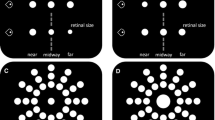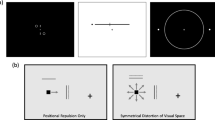Abstract
The Oppel-Kundt illusion (OKI) consists of the perception of a filled space as larger than an empty space of the same size. Here, we used a modified version of that illusion composed of a gradient of vertical lines whose spacing decreased progressively from one side to the other: space is expected to be perceived as larger where the lines are more compressed. We tested the hypothesis that a horizontal stimulus presented in a space perceived as larger will produce faster RTs by asking forty-four healthy subjects to respond as quickly as possible to lateralized stimuli (horizontal bars, vertical bars and circles) presented on different backgrounds (control condition: evenly spaced vertical lines or an empty space; illusory conditions: vertical lines progressively compressed to the right or the left). Subjects’ RTs were reliably faster for horizontal stimuli presented on the space perceived as larger than on the space perceived as smaller. To verify that this effect was actually due to a size illusion, the same subjects were asked to adjust the size of the stimuli presented on the same backgrounds as to make them equal to a reference stimulus. For horizontal stimuli, subjects produced adjustments in accordance with the predicted effect of the illusion. Together, these data show that the OKI produces a distortion of space that extends to stimuli placed in front of it and that RTs are influenced by the perceived and not the physical size of the stimuli. Implications for neural bases of illusions and for spatial neglect are discussed.



Similar content being viewed by others
References
Bisiach E (1997) The spatial features of unilateral neglect. In: Thier P, Karnath H (eds) Parietal lobe contribution to orientation in 3D space. Springler Verlag, Berlin, pp 465–495
Bisiach E, Ricci R, Modona MN (1998) Visual Awareness and anisometry of space representation in unilateral neglect: a panoramic investigation by means of a line extension task. Conscious Cogn 7:327–355
Bisiach E, Neppi-Modona M, Genero R, Pepi R (1999) Anisometry of space representation in unilateral neglect: empirical test of a former hypothesis. Conscious Cogn 8:577–584
Bisiach E, Neppi-Modona M, Ricci R (2002) Space anisometry in unilateral neglect. In: Karnath HO, Milner AD, Vallar G (eds) The cognitive and neural basis of spatial neglect. Oxford University Press, Oxford, pp 145–152
Bulatov A, Bertulis A (1999) Distortions of length perception. Biol Cybern 80:185–193
Bulatov A, Bertulis A, Mickienè L (1997) Geometrical illusions: study and modelling. Biol Cybern 77:395–406
Cavina-Pratesi C, Bonato E, Bricolo E, Prior M, Posteraro L, Marzi CA (2001) Hyperattention in neglect patients: perceptual or pre-motor phenomenon? Cortex 37:703–705
Coren S, Girgus JS (1978) Seeing is deceiving: the psychology of visual illusions. Lawrence Erlbaum Associates, Hillsdale
De Renzi E, Gentilini M, Faglioni P, Barbieri C (1989) Attentional shift towards the rightmost stimuli in patients with left visual neglect. Cortex 25:231–237
Deregowski JB, McGeorge P (2006) Oppel-Kundt illusion in three-dimensional space. Perception 35(10):1307–1314
Gainotti G, Tiacci C (1971) The relationships between disorders of visual perception and unilateral spatial neglect. Neuropsychologia 9:451–458
Gallese V (2007) The ‘conscious’ dorsal stream: Embodied simulation and its role in space and action conscious awareness. Psyche 13 http://www.theassc.org/files/assc/2666.pdf
Garner WR (1974) The processing of information and structure. Erlbaum, Potomac
Gibson JJ (1950) The perception of the visual world. Houghton Mifflin, Boston
Giora E, Gori S (2010) The perceptual expansion of a filled area depends on textural characteristics. Vis Res 50(23):2466–2475
Gregory RL (1963) Distortion of visual space as inappropriate constancy scaling. Nature 199:678–680
Gregory RL (1968) Perceptual illusions and brain models. Proc R Soc Lond B Biol Sci 171:279–296
Irving-Bell L, Small M, Cowey A (1999) A distortion of perceived space in patients with right-hemisphere lesions and visual hemi neglect. Neuropsychologia 37:919–925
Kundt A (1863) Untersuchungen über Augenmass und optische Täuschungen. Poggendorffs Annalen der Physik und Chemie 120:118–158
Ladavas E, Petronio A, Umiltà C (1990) The deployment of visual attention in the intact field of hemi neglect patients. Cortex 26:307–317
Ladavas E, Carletti M, Gori G (1994) Automatic and voluntary orienting of attention in patients with visual neglect: horizontal and vertical dimensions. Neuropsychologia 32:1195–1208
Marzi CA, Natale E, Anderson B (2002) Mapping spatial attention with reaction time in neglect patients. In: Karnath HO, Miller AD, Vallar G (eds) The cognitive and neural basis of spatial neglect. University Press, Oxford, pp 275–288
Marzi CA, Mancini F, Metitieri T, Savazzi S (2006) Retinal eccentricity effects on reaction time to imagined stimuli. Neuropsychologia 44:1489–1495
Milner AD (1987) Animal models for the syndrome of spatial neglect. In: Jeannerod M (ed) Neurophysiological and neuropsychological aspects of spatial neglect. Elsevier, Amsterdam, pp 259–288
Milner AD, Goodale MA (2008) Two visual systems re-viewed. Neuropsychologia 46:774–785
Milner AD, Harvey M (1995) Distortion of size perception in visuospatial neglect. Curr Biol 5:85–89
Milner AD, Harvey M, Roberts RC, Forster SV (1993) Line bisection errors in visual neglect: misguided action or size distortion? Neuropsychologia 31:39–49
Milner AD, Harvey M, Pritchard CL (1998) Visual size processing in spatial neglect. Exp Brain Res 123:192–200
Natale E, Posteraro L, Prior M, Marzi CA (2005) What kind of visual spatial attention is impaired in neglect? Neuropsychologia 43:1072–1085
Oppel JJ (1855) Über Geometrisch-optische Täuschungen. Jahresbericht des physikalischen, Vereins zu Frankfurt am Main, pp 37–47
Osaka N (1976) Reaction time as a function of peripheral retinal locus around fovea: effect of stimulus size. Percept Mot Skills 42:603–606
Ricci R, Calhoun J, Chatterjee A (2000) Orientation bias in unilateral neglect: representational contributions. Cortex 36:671–677
Ricci R, Pia L, Gindri P (2004) Effects of illusory spatial anisometry in unilateral neglect. Exp Brain Res 154:226–237
Rizzolatti G, Matelli M (2003) Two different streams form the dorsal visual system: anatomy and functions. Exp Brain Res 153:146–157
Robertson LC, Kim MS (1999) Effects of perceived space on spatial attention. Psychol Sci 10:76–79
Savazzi S (2008) Reply: no reversal of the Oppel–Kundt illusion with short stimuli: confutation of the space anisometry interpretation of neglect and ‘crossover’ in line bisection. Brain 131:e95
Savazzi S, Frigo C, Minuto D (2004) Anisometry of space representation in neglect dyslexia. Cogn Brain Res 19:209–218
Savazzi S, Posteraro L, Veronesi G, Mancini F (2007) Rightward and leftward bisection biases in spatial neglect. Two sides of the same coin? Brain 130:2070–2084
Smania N, Martini MC, Gambina G, Tomelleri G, Palamara A, Natale E, Marzi CA (1998) The spatial distribution of visual attention in hemi neglect and extinction patients. Brain 121:1759–1770
Sperandio I, Savazzi S, Gregory RL, Marzi CA (2009) Visual reaction time and size constancy. Perception 38:1601–1609
Sperandio I, Savazzi S, Marzi CA (2010) Is simple reaction time affected by visual illusions? Exp Brain Res 201(2):345–350
Weidner R, Boers F, Mathiak K, Dammers J, Fink GR (2010) The temporal dynamics of the Müller-Lyer illusion. Cereb Cortex 20(7):1586–1595
Acknowledgments
This study has been supported in part by a Fulbright Research Scholar grant to the first author.
Author information
Authors and Affiliations
Corresponding author
Rights and permissions
About this article
Cite this article
Savazzi, S., Emanuele, B., Scalf, P. et al. Reaction times and perceptual adjustments are sensitive to the illusory distortion of space. Exp Brain Res 218, 119–128 (2012). https://doi.org/10.1007/s00221-012-3012-0
Received:
Accepted:
Published:
Issue Date:
DOI: https://doi.org/10.1007/s00221-012-3012-0




